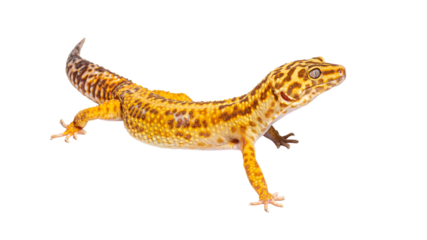As responsible reptile and amphibian keepers, we should always strive to improve our husbandry practices to ensure our pets live long, healthy lives. The world of reptile care is constantly evolving as new research and advancements in husbandry techniques emerge, and advancing our reptile care is important as more information comes out. Whether you’re keeping leopard geckos, ball pythons, dart frogs, or monitor lizards, there are always ways to refine and enhance their environment, diet, and overall well-being.
Even if you’ve been caring for reptiles for years, small changes—like improving UVB lighting, diversifying their diet with gut-loaded insects, or monitoring humidity levels more precisely—can have a significant impact on your pet’s health. Modern advancements in reptile care, such as bioactive enclosures, digital tracking tools, and updated feeding strategies, allow us to provide more naturalistic and enriching setups than ever before.

While there are widely accepted best practices in reptile and amphibian care, it’s important to remember that there isn’t always a single “right” way to keep these animals. Factors such as species, individual temperament, enclosure type, and even your home’s climate can all influence the best approach to husbandry. The recommendations in this post are intended to help you refine and improve your care, but ultimately, it’s up to you to decide what works best for your pets. By staying open to new information and continuously researching, you can make informed choices that enhance the well-being of your reptiles and amphibians while creating a care routine that fits your specific setup and lifestyle. Even implementing one or two of the tips below is a step towards advancing reptile care standards!
By staying informed, regularly assessing our husbandry standards, and making proactive adjustments, we can ensure our reptiles, amphibians, and invertebrates thrive in captivity. Whether you’re caring for geckos, snakes, or amphibians, here are five ways to level up your reptile care in 2025!
1. Upgrade Their Diet
A well-balanced diet is essential for your reptile’s health. Imagine spending your whole life only eating 2 or 3 food options. Not only would you get bored quickly, but your body would not be able to get all of the proper nutrients. Too often, keepers rely on just one or two staple feeders, but variety is key to proper nutrition and the overall health of your pet. It is important to research what your reptile might eat in the wild, and see how you can replicate that for them. And remember to switch their food up often – new foods are great enrichment, and keep our animals from getting too picky.
Here’s a few tips for how you can improve your pet’s diet:
- Gut-load their feeder insects – Gut loading insects means feeding the bugs high quality greens, fruits and veggies BEFORE feeding them to your reptile. This will ensure that the crickets, dubia roaches, and other feeders are packed with nutrients before feeding them to your reptile.
- Supplement properly – Calcium and vitamin D3 are essential for most reptiles to prevent metabolic bone disease (MBD), while a good multivitamin helps for overall health. Research species-specific supplement schedules and add these on top of their food.
- Introduce variety – Instead of just feeding mealworms or crickets, mix it up! Try silkworms, black soldier fly larvae, hornworms, locusts or snails (depending on species).
- Fresh greens and fruits – For herbivorous or omnivorous reptiles like bearded dragons and tortoises, provide a diverse mix of leafy greens, vegetables, and some fruits.
2. Perfect Their Habitat
Mimicking a reptile’s natural environment in captivity is crucial for their health and well-being, as it reduces stress and allows your pet to engage in natural behaviors. To put it simpler: Your reptile’s enclosure setup has a direct impact on their health. Now more than ever naturalistic and bioactive enclosures are taking off in popularity, with owners noticing immediate change in their pets’ behaviors. The simple changes below can offer great enrichment for our pets, and offer owners the chance to see a unique and personal view of animal behaviors that have evolved over centuries! Read the tips listed below see what steps you can take towards advancing your reptile care standards. Take the time to reassess their habitat and make any necessary upgrades.
Here are some ways you can update their habitat:
- Optimize temperatures – Maintaining the proper temperature is a requirement for successful reptile keeping, and each species has their own preferred temps! A bull snake might prefer their hot spot around 85°F, while a bearded dragon prefers theirs at 100°F. Investing in a probe thermostat is a great way to keep your heating elements at the proper temperature.
- Add some UVB – UVB is vital for reptiles to process calcium, and helps prevent health issues like Metabolic Bone Disease. Even nocturnal animals can benefit from low amounts of UVB exposure! Research your pet’s preferred U.V Index and choose the proper bulb for them. Make sure you’re using high-quality, species-appropriate lighting. Replace UVB bulbs every 6-12 months.
- Optimize humidity levels – Just like they have proper temperature needs, various animals might need different levels of humidity. Use digital hygrometers to ensure proper humidity levels, especially for tropical species.
- Ensure proper substrate – Many reptile owners are switching to bioactive or loose substrate for most reptile and amphibian species rather than using paper towels or reptile carpet. Not only does substrate help maintain humidity levels, it also promotes natural burrowing and digging behaviors in plenty of pets!
3. Regular Weigh-Ins
Reptile care doesn’t stop at offering regular food and water. Owners must be knowledgable about their pets’ overall wellness. Weight tracking is an easy way to monitor your reptile’s health, but it’s often overlooked by casual reptile keepers. Most reptiles and amphibians don’t show obvious early signs of illness. While this might help them in the wild (a sick animal is an easy target for predators) it makes diagnosing problems in our pets very difficult. A significant change in weight can be an early indicator of illness, parasites, or improper feeding. Tracking your pet’s weight is a great way to catch health problems early, and their long term weight data could help your vet team!
Here’s how to start tracking their weight:
- Invest in a digital scale – Choose one that measures in grams for accuracy. Ensure your scale is big enough to hold another container like tupperware or a critter-keeper for an easier way to weigh your pets.
- Track trends – A slight variation is normal, but sudden weight loss should be addressed immediately.
- Log data consistently – Record weights weekly or monthly for an accurate long-term picture of your reptile’s health.
4. Start Routine Health Checks
Because reptiles and amphibians are so skilled at masking illness, early detection is crucial to preventing serious health issues. By performing routine health checks, you can catch subtle signs of problems before they become major concerns. A quick weekly inspection can help you monitor changes in weight, skin condition, behavior, and overall well-being.
Here are some key areas to focus on during your regular health assessments:
- Inspect eyes, nose, and mouth – Look for discharge, swelling, or mouth rot.
- Check shedding – Retained shed, especially around toes and tails, can lead to circulation issues.
- Look for external parasites – Mites and ticks are common in some reptiles and require prompt treatment.
- Monitor behavior – Lethargy, excessive hiding, or lack of appetite can indicate stress or illness.
5. Keep Detailed Records
Tracking your reptile’s care routine is one of the most effective ways to ensure their long-term health and well-being. By keeping detailed records of feeding schedules, shedding cycles, weight fluctuations, and overall behavior, you can quickly identify patterns or potential health concerns before they escalate. Consistent documentation also helps you adjust care routines, monitor breeding projects, and track veterinary visits.
Here are some key aspects of reptile care that are worth recording:
- Feeding Schedules – Track what and when your reptile eats to ensure they’re getting a balanced diet and maintaining a healthy appetite. Plus it’ll help you remember what they ate last, ensuring you add in variety!
- Shedding Cycles – Logging shed dates helps you spot irregularities, such as stuck shed or abnormal shedding frequency.
- Weight Monitoring – Regular weigh-ins can alert you to sudden weight loss or gain, which may indicate underlying health issues.
- Behavioral Observations – Noting changes in activity levels, basking habits, or aggression can provide early signs of stress or illness.
- Vet Visits & Treatments – Keeping records of veterinary appointments, medications, and treatments ensures you have a full medical history for reference.
Keep it All Organized with Husbandry.Pro
Keeping track of all this information can feel overwhelming, but Husbandry.Pro makes it easy! This all-in-one reptile tracking software allows you to log feedings, weights, health records, breeding data, and more—all in one convenient place. Whether you’re managing a single pet or an entire collection, Husbandry.Pro helps you streamline your record-keeping and make informed care decisions.


Want to try it out? Use my code TinyZoo60 for an exclusive 60-day free trial and take your reptile care to the next level!

Final Thoughts
Small improvements in husbandry can have a huge impact on your reptile’s health and longevity. Whether it’s upgrading their diet, improving their enclosure, or staying organized with digital tracking, 2025 is the year to take your reptile care to the next level.
How are you improving your reptile care this year? Let me know in the comments!



